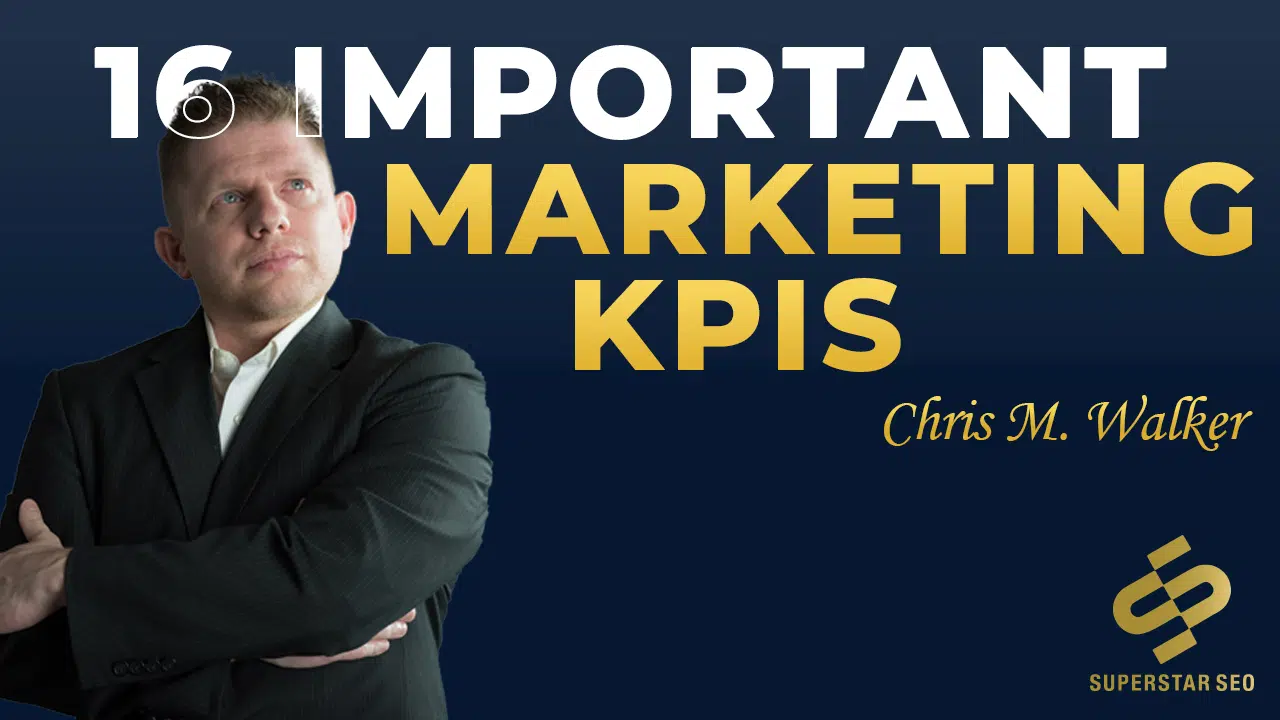16 Marketing KPIs to Use In Your Marketing
Marketing KPIs are a set of metrics that companies use to measure the effectiveness of their marketing campaigns. Marketing KPIs can be quantitative or qualitative, depending on the company’s goals and objectives.
Marketing KPIs are either companywide or department-specific. Marketing KPIs are indicated by specific key performance indicators numerical marketing metrics that companies track to measure your progress towards a defined goal within your marketing channels.
These Marketing KPIs can be used on their own or compared with each other to gain more insight into the effectiveness and impact of your campaigns. Marketing KPIs provide numerical data about a company and help marketers and business leaders make strategic decisions.
In this article, we will explore 16 Marketing KPIs that all marketers should know about to make informed decisions about their marketing efforts. We will break them down into 3 easy-to-digest categories: Traffic and Revenue, Website and Content, and Email Marketing.
1. Traffic and Revenue
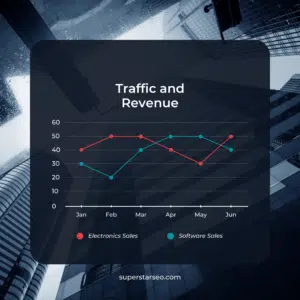
One of the first things you should track using KPIs will usually relate to traffic and revenue. After all, these are the main topics that will keep you going and bring your business the needed income to stay alive, so track it accordingly!
Here are the main KPIs to measure to know if your marketing effort is working.
2. Cost Per Click
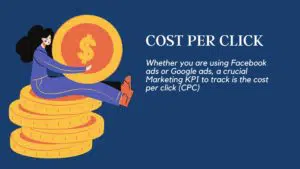
Whether you are using Facebook ads or Google ads, a crucial Marketing KPI to track is the cost per click (CPC). The CPC is a key indicator of how much you’ll have to pay for new customers. CPC is calculated by dividing the total expenses for promoting products and services by the number of clicks you receive on your ads.
Another Marketing KPI that falls under this category is the cost per impression (CPM), which calculates the money spent to show your ads divided by the number of times they were viewed. This is usually calculated “per 1000 views”.
When thinking of performance, you want to keep this number competitive. When you want to optimize your marketing efforts, you will therefore try to lower your CPC or CPM.
Why it’s important: Tracking CPC is one of the easier KPIs to track. Most marketing platforms give this information on their dashboards. That being said, knowing what each ‘click’ costs you help you control profit for your company.
If your CPC is going up, you are either in market demand (more competition) or you are not paying attention to your budget!
3. Conversion Rate
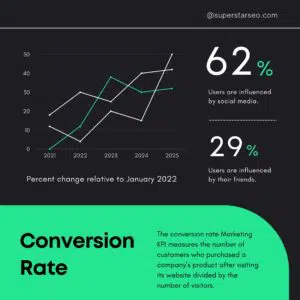
The conversion rate Marketing KPI measures the number of customers who purchased a company’s product after visiting its website divided by the number of visitors. Conversion rates are one of the most important Marketing KPIs because they show how effective your site is at turning visitors into paying customers.
Marketing KPIs like the conversion rate gives you control over your business’s prospects and can indicate whether or not your website is doing well (i.e., increasing revenue, reducing costs, increasing customer satisfaction).
Why it’s important: Conversions tell you the truth. If your conversions are low, your offer may not be compelling enough, or you may not be providing the right information the user was expecting.
We’ll get into your site performance a bit later on, but ultimately, the conversion rate is where the rubber meets the road.
4. Cost Per Sale
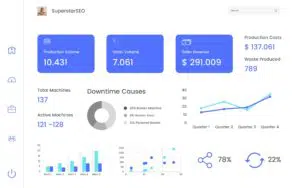
Going hand-in-hand with conversions, the cost per sale KPI is also an integral part of your marketing KPIs. If you understand your costs per sale, you can determine your maximum sales price without losing money.
Keep in mind that the Marketing KPI cost per sale is not the same as average order value (AOV), which is calculated by adding up all of your transactions and dividing them by the total number of sales transactions.
Why it’s important: Tracking what you spend to get a conversion is important for understanding where your marketing dollars are going. If conversions are on the rise but your costs per sale are also increasing, it’s time to take action to reduce the cost of customer acquisition.
You may also like – Best Niche Ideas For Affiliate Marketing & Online Business
5. Customer Lifetime Value

When it comes to understanding your book of business, or existing customers, tracking the KPI for Customer Lifetime Value (CLV) will give you predictability over your revenue in the future. The CLV Marketing KPI gives you a metric for understanding the profitability of your customers over time.
An example of this is when a current customer is a subscriber to a service you offer. If your average customer stays for 15 months, and your average subscription is $20UD, then your CLV is $300.
With this metric, you can adjust the prior KPIs, such as CPC or Cost per sale, to match this value.
Why it’s important: Getting a handle on how much a customer is worth to your company will give you a better idea of which marketing strategies are working best and help establish an effective marketing spending plan.
6. Direct Traffic
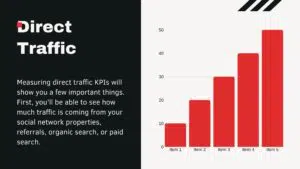
Measuring direct traffic KPIs will show you a few important things. First, you’ll be able to see how much traffic is coming from your social network properties, referrals, organic search, or paid search.
You can also measure the bounce rate of marketing KPIs between direct, referral, and organic traffic. Perhaps it’s time to move some content around on your site so that visitors are not bouncing back to Google after landing on your Marketing KPI’s blog post. Again, bounce rates will be brought up later in this article.
Why it’s important: Direct traffic Marketing KPIs can help you re-evaluate your organic search strategies and understand how to improve the user experience on your site. Bounces are generally bad, but if you’re getting direct customer conversions during this bounce time, those Marketing KPIs will have a positive impact on your business.
Similar Article – SEO Marketing Strategy
7. Website and Content Performance
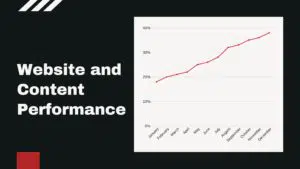
Your website is responsible for so much of your business, so the KPIs related to your website will typically be based on the content and the pages you send the user to.
KPIs like time on site, page views per visit will help you understand how engaged customers are with your online content. Abandonments will also give you some metrics about your content or offer as well.
So often a great offer is ruined by a bad site or bad content. Even the simple mistake of sending someone to the wrong page can be the difference between a conversion or a bounce. Let’s dig into the marketing KPIs for your website and content.
8. Landing Page Bounce Rate
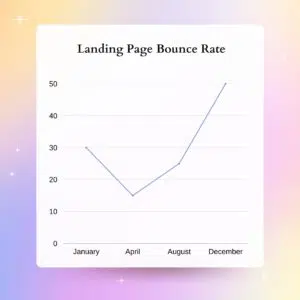
Website bounce rates can tell you a lot about your website setup. The Marketing KPI bounce rate is defined as the percentage of people who land on your Marketing KPIs website and then “bounce” out, or leave without engaging in any way.
Several factors can lead to a high bounce rate, such as:
- Slow-loading website
- The wrong information is given to the user
- Bad content
- Poor website design
Having a high bounce rate can cost you money. Your cost per conversion could go up. Your cost per sale could go up.
You would even see your time-on-site marketing KPIs go down.
Why it’s important: Marketing KPIs like bounce rate can show you exactly what issues need to be fixed with your website and content before customers leave and costs rise for your company. Getting this KPI measured and under control will also keep your organic traffic KPI on the rise.
Related – Types of Digital Marketing
9. Form Conversion Rate
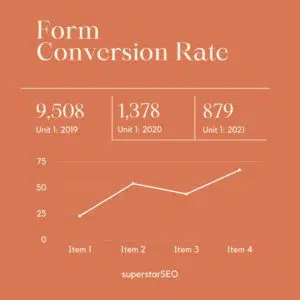
When we say the word form, we mean any type of information gathering: shopping cart, newsletter, request for information.
Understanding this KPI will let you know if there is any user or buyer hesitation. If your offer is solid you won’t see a lot of abandoned forms at the end.
From this form conversion rate, you can tie it to the KPI for cost per sale. If you take the form of conversions and divide by sales, you will have a KPI that accurately measures the strength of your offer.
Even if customers go through to input their information, but they don’t complete the form or sign up, it creates conversion anxiety.
Why it’s important: Marketing KPIs like form conversion rate measures the effectiveness of any type of call-to-action on your site. This Marketing KPI can help you put more focus on lead generation and offer performance to retain customers and build a larger pool for future marketing campaigns.
10. Time on Site
Measuring the time on a site is another indication of your website’s content or effectiveness. Marketing KPIs like time on site can help you identify slow-loading pages or poor content.
Put another way, users who spend time engaged on your site are likely to be more successful conversions.
Conversely, high bounce rates could be a bad sign for your time-on-site Marketing KPI as well.
Why it’s important: This marketing KPI can help you identify which web pages and content are working and which need improvement. If you see short time-on-site numbers next to high bounce rates, you know that there’s an issue on the page.
You may also like – Affiliate Marketing Tools
11. Average Page Views per Visit
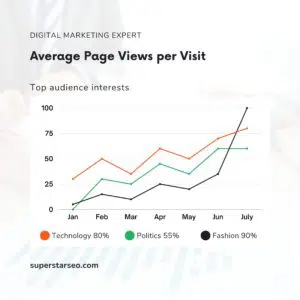
Many marketers don’t realize that average page views can indicate engagement levels as well. This KPI will help you understand user behavior, and whether or not they are clicking around your site to find relevant information.
Pages with fewer than 2-3 pages viewed per visit may show a lack of interest. Many marketers are not aware of the fact that this could indicate a lack of urgency on their users’ part, or they simply aren’t interested in your products.
You might also look at pages with more than 4-5 page views per visit as well. They could show that users are interested and have viewed multiple pages on your website, but are not committed to buying yet.
Why it’s important: If you see high time-on-site numbers and average page views per visit, you know that users are engaged with your site and content. This can be a powerful KPI of sales closing soon if these rates stay consistent over the week or month.
12. Email Subscription Rate

Email subscription rates may seem like a KPI that you don’t think about, however, it’s one of the most important. This metric shows how many users are subscribed to your content or marketing emails, and opens you up for a low-cost marketing option.
But getting an email can be tough nowadays. Offering something they would want is the hardest part of this. But you do not want to overthink this.
Give away something valuable. Not a newsletter. Nobody cares that much.
Instead, offer a free month of service, or a discount of some sort. Show them their email is valuable, and you will likely get a subscriber, and your email subscription KPIs will also go up!
Why it’s important: Reaching a large number of email subscribers is a great way to reach a small portion of your audience at a low cost. You can also consider this as one step closer to closing the deal with the customer.
Now that we are on to email KPIs, let’s talk about measuring their performance.
13. Email Marketing Performance
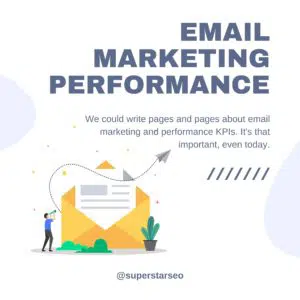
We could write pages and pages about email marketing and performance KPIs. It’s that important, even today.
Whether you are keeping in touch with existing customers, or using constant email ‘touch’ to new email subscribers, understanding how your email performs can make or break your email efforts.
There are many KPIs like we mentioned, but there are three basic KPIs to measure when it comes to basic performance tracking.
14. Email Open Rate
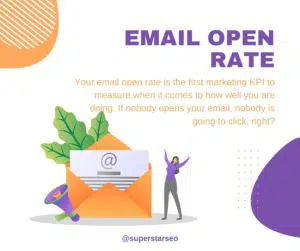
Your email open rate is the first marketing KPI to measure when it comes to how well you are doing. If nobody opens your email, nobody is going to click, right?
That being said, how can you tell how to fix a bad email open rate KPI? First, understand that email open rates vary on many things, such as:
- Subject Line
- How far the recipient is into the campaign (first email, second, tenth?)
- Familiarity of your company/branding
- What you have offered/provided in the past
Typically, the first 3 emails you send will have a higher open rate. Your email is fresh, and you probably sent them something of value in the first or second email.
If you have an aged list of customers or subscribers, you will need to keep it interesting to get out of the email ‘weeds’ of the inbox.
If you find that your KPIs for open rates are going down, consider split testing subject lines, especially if this is an existing customer list.
KPI for open rates will naturally go UP as you add new subscribers, so be sure to track those separately to prevent skewing the metric.
Why it’s important: Email open rates are one of the best marketing KPIs to know if your audience is interested in what you have to offer. This can indicate many things, including whether or not you should continue emailing them.
15. Email Click-Through Rate
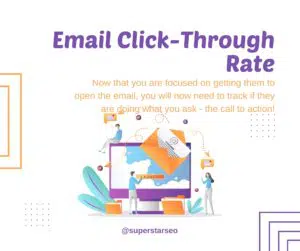
Now that you are focused on getting them to open the email, you will now need to track if they are doing what you ask – the call to action!
Creating an email click-through KPI will help you understand the content of your email as well as what you are asking the reader to do.
You are working hard to get them to open the email, so why not focus on the click (conversion)?
Be sure you are getting to the point of the email. The subject should relate to what your content is about, so the call to action makes sense.
For example, if you send an email about the latest news from your company, don’t ask them to ‘click to subscribe’. That has nothing to do with what they are reading.
Why it’s important: If you have a good open rate, but a poor click-through KPI, it is obvious that your audience is interested in you, but not necessarily the services or products you offer. This will help to identify content gaps and opens up new opportunities for digital marketing KPIs.
16. Email Unsubscribe Rate
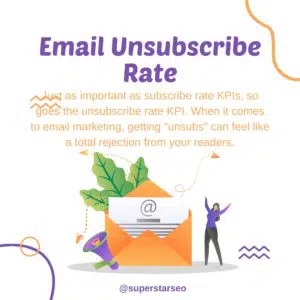
Just as important as subscribe rate KPIs, so goes the unsubscribe rate KPI. When it comes to email marketing, getting “unsubs” can feel like a total rejection from your readers.
This is pretty much the truth, but never a personal thing (usually). When you are tracking this as a KPI, you can better understand the quality or frequency of the email you are sending to your list.
For example, if you send an email to your list and start getting unsubscribe rates, take a look at the content and subject line of this email. If it is different than previous emails, it may be that subscribers are seeing things they don’t want to subscribe to – or that you have gone too far with promotions, etc.
If your unsubscribe rate KPI goes up after sending emails to the same list, you might need to send less frequently (or at least more like your first email).
Why it’s important: It is always better to track unsubscribe rates because this will identify which of your campaigns are not working, allowing for other email marketing KPIs that can be optimized.
You may also like – 26 Example of Brilliant Email Marketing Template
Final Thoughts on Marketing KPIs
When it comes to your business and marketing, there are many KPIs that will show you how well you are doing in each segment. As you can tell, this can get very deep and complicated if you let it.
We recommend tracking some of the basic KPIs we talk about in this article. Not only will you have a better understanding of how your campaigns are doing, but you will also have something to share with your boss or CEO.
Tracking costs, conversions, as well as email campaigns, can lead you to new strategies. This can help you optimize your marketing, allowing for increased sales and lower costs.
Using the right digital marketing KPIs is key to monitoring your brand’s health, staying on top of your revenue goals, and having higher customer satisfaction.



